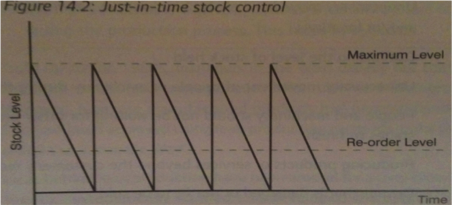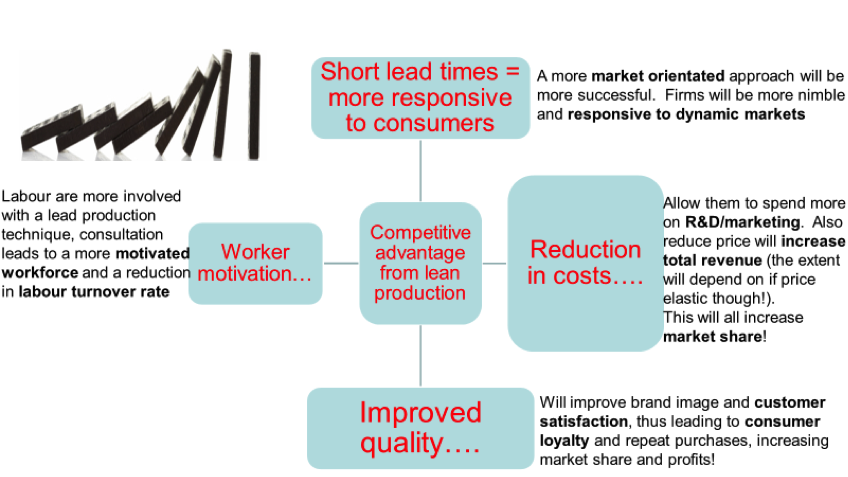Efficiency and competitiveness using lean production
Quality
Quality Control:
- Traditional method of checking products are a good enough standard and are capable of doing what they are intended to do.
- Inspected during and at the end of production via a ‘quality control inspector’ looking for faults.
- Sample inspections, etc. But this is not a full proof method!
-
Faulty products can still ‘slip the net’ and reach consumers. Which results in unhappy customers and bad PR.
-
System makes no attempt to find out why mistakes happen – the purpose is just to prevent faulty goods reaching the customer.
-
System reinforces concept that mistakes are unavoidable and that the workforce do not need to worry about quality – sure it is someone else’s job?
-
Expensive to implement, wastes ‘faulty’ stock and does not add value.
Quality Assurance:
-
Assumes, unlike quality control, that mistakes can be prevented and that it’s possible to produce high quality output all of the time.
-
QA involves a collaboration between everyone working in design, production and marketing. It involves working together towards improving quality and reliability at each stage of the production process – everyone has a responsibility of the need for quality.
-
This means focusing on the prevention of defects, rather than just checking for them at the end. Some QA policies aim for zero-defects! This focusses on getting the product right the first time so that wastage is minimised, reducing costs as a consequence.
- How is it attained? Corporate culture (‘ways of doing things’) of quality, higher standards of production (ISO 9000), industry codes of practice, lean production ideas (kaizen, TQM, Muda, etc) and benchmarking (comparing your business to other businesses with excellent quality standards).
- Many businesses will also expect their own quality assurance standards to be applied by their suppliers as well to ensure high quality components.
Total Quality Management:
-
Employees involved in quality control and take responsibility for the quality of their own/team’s work. This helps reduce costly wastage and reinforces employee motivation.
-
TQM involves everyone committing to improving quality. Each team regards the next stage of production as its customer – i.e. someone who expects a high quality product.
-
The drive for quality/reliability runs right through the whole production process.
-
TQM needs fully committed leadership and employees need to be empowered – they must have the power to make changes (requires training, time and effort).
-
Business will need__ close relationship with customers and with suppliers__ as well.
- Benefits: Competitive advantage, increased quality and therefore satisfaction/brand loyalty/repeat purchases, profitability improves as costs reduced and productivity raised as more motivated workforce.
- Drawbacks: Time consuming, costly to set up, resistance to new systems/training and may not be effective in some businesses.
Continuous Improvement (Kaizen):
- A whole company approach to quality control.
-
Focuses on numerous small improvements rather than sudden/radical change.
-
It’s about gradual evolution rather than sudden revolution – thus more sustainable.
- Involves everyone in the search for improvements to both the product and the process of production.
-
Everyone has a part to play in monitoring and improving quality wherever possible.
-
This culture will continuously improve a product/service – customers benefit and subsequently satisfaction/repeat purchases/brand loyalty develops.
- Quality circles are a big aspect of Kaizen.
- Only effective when: Everyone participates, leadership supports, staff empowered/trained and staff have full access to ‘the whole picture’.
- How will Kaizen motivate staff? By encouraging commitment and interest, leading to job satisfaction, motivation and increased productivity.
Lean Production
-
Japanese products are renown for their reliability and quality and this was achieved via a unique management style called ‘the Japanese way’.
-
This approach originated with the car manufacturers Toyota and thus ‘lean production’ was born.
-
LP covers a variety of techniques to cut down on waste and therefore__ increase efficiency__. These were invented by the Japanese.
-
It’s principle is to eliminate waste and have continuous improvement (Kaizen).
-
It called for every employee to be part of a team that would seek out better ways of organising the production process and sometimes product improvements as well.
-
It reduces the time between production and the product being on the shelf (lead times), to as quick as possible.
Just-in-Time Production
-
Focuses on reducing the need to hold stocks (and have moneytiedupinthem)
-
All kinds of stock – Raw materials/components, work-in-progress items and finished items
-
RM are delivered JIT to be used in the production process (thusa good relationship with suppliers is essential!)
-
Parts are made JIT for the next stage of production
-
Finished products are made JIT to be delivered to the customer.
-
All this reduces the cost of holding stock – as no extra stock (buffer stock) is held. And reduces lead times (delivery/development time) to an absolute minimum.
-
Thus extra warehouses are not needed – reducing costs. Finished products are sold quickly – increasing cash flow.
-
E.g., Amazon
Competitive advantage from Lean Production
The ‘Japanese Way’ has aided Japanese firms to gain a competitive advantage over Western firms (see the spider diagram below).
| ADVANTAGES OF LEAN PRODUCTION | DISADVANTAGES OF LEAN PRODUCTION |
| Reduces wastage and related costs | Does not suit all production processes |
| Reduces cost of storage and handling | Supplier may let you down…. |
| Improves quality | Workers may dislike greater responsibility |
| Fewer reject costs | Managers may not be flexible enough |
| Customers more satisfied with quality | |
| Greater flexibility | |
| Shorter lead times (time between order and delivery) | |
| More motivated staff, less leavers |


